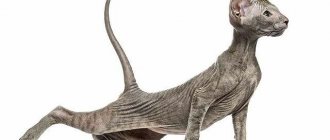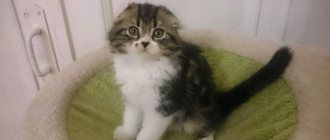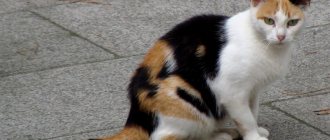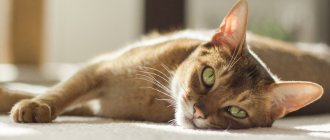History of the Ragdoll breed
Ragdoll
The history of ragdoll began in the 60s of the last century. It is full of hoaxes and is associated with high-profile trials. Ragdolls owe their appearance to an enterprising lady from California, Ann Baker, who bred Persian cats, and to the cat Josephine, a long-haired beauty of a mixed breed (presumably Persian and Angora), who lived with the breeder’s neighbor. Baker bought Josephine's kittens, many of which were unusually calm in nature. She later used them to breed a new breed.
Having become famous, in her interviews the breeder claimed that Josephine was once hit by a car and ended up in a clinic where she was subjected to secret genetic experiments conducted by the CIA. Allegedly, as a result of this, the kittens that she gave birth to after the accident had special qualities: decreased muscle tone, increased pain barrier, amazing calmness. There were also incredible rumors that ragdolls were of alien origin. What was the basis of these stories - the eccentricity of Ann Baker or a publicity stunt of specialists promoting the breed - is not known exactly, but ragdolls are indeed different from all other cats in their physiology and character. According to rational experts, most likely Josephine simply had a special combination of recessive genetic traits. Subsequently, Ann Baker purposefully selected the calmest and most balanced animals for mating.
The creation of a new breed began with the offspring of Josephine, which appeared after crossing her with a Burmese cat, whose color included charcoal gray colors. Continuing the breeding work and wanting to “decorate” her pets in the other two primary colors - white and brown - Ann Baker introduced Burmese with dark brown markings to mating. Whether they were purebred is unknown, since the breeder did not document the first matings, but she loved to experiment.
Ragdoll kitten
In 1971, Anne Baker founded her own registry, called the International Ragdoll Cat Association (IRCA). Thanks to this organization, the founder of the Ragdoll breed retained control over the standard of these cats and the registered Ragdoll brand for several decades. Baker sold franchises to breeders, which meant that IRCA-member breeders had to pay licensing fees, breed Ragdolls strictly according to instructions, and pay a 10% royalty on each kitten sold. Major American and international felinological organizations, in turn, did not recognize IRCA.
In 1975, shareholders and breeders, dissatisfied with the Association's business strategy and Anne Baker's dubious claims about the origins of the Ragdoll, broke away from IRCA and founded the Ragdoll Society (RFCI). The new organization has set itself the goal of achieving official standardization of the breed and recognition of it by eminent felinological associations in the United States. The “divorce” was accompanied by a loud scandal, followed by many years of litigation.
Several decades passed before the RFCI managed to achieve championship status for the Ragdoll in all major North American cat associations, and only in 2000 the Ragdoll took part in the CFA Championship (International Association for the Breeding of New Breeds of Cats).
A sweet, flexible, wonderful cat is a ragdoll.
Thanks to their gutta-percha, ragdolls can take a variety of poses, sometimes completely unimaginable.
However, not only disputes over the rights to own the Ragdoll trademark have long been a problem for this breed. Due to the similarity of ragdolls to Burmese cats, many judges at championships constantly had problems identifying these animals: some breeders breeding Burmese cats presented their pets that did not meet the standards as ragdolls. The similarity of the Ragdoll with the Balinese cat also created problems for the breed at exhibitions and during registration in various felinological associations. Some confusion between Burmese, Balinese and Ragdolls is still the subject of debate in felinological circles today.
Despite all the ups and downs that accompanied the emergence of the Ragdoll breed, millions of people in the USA, Europe, and Australia gave their hearts to these beautiful, smart, gentle and devoted cats. They appeared in Russia about ten years ago, but, despite all their charm, they are not yet among the most popular cat breeds among Russians.
History of creation
Bred in the state of California (United States of America) in the 60s of the twentieth century.
The ancestor of these cute animals is the snow-white Angora cat Josephine. Bridder Annie Baker took her out after the accident and placed her in her kennel. Josephine's character changed in an amazing way - she was striking with her pathological attachment to her mistress, calmness and somewhat reduced muscle tone. As a result of crossing a white Josie with a color-point Burmese cat, kittens with an unusual coloring and mother’s character were born. They gave rise to the new Ragdoll breed, officially registered in 1965.
Annie Baker continued to experiment with Josephine's new litters from other cats and began breeding Ragamuffins.
Ragamuffin
Other American breeders, the married couple Denny and Laura Dighton, continued to popularize the “Rag Doll.” They developed a breed standard approved by felinological associations: first CFA (Cat Fanciers' Association), in 1991 by the English organization GCCF and in 1992 by FIFe, later by TICA. At that time it was the largest domestic cat, and in 1986 it was included in the Guinness Book of Records.
Further development of the breed took place in the United Kingdom of Britain. The Ragdoll Fanciers' Club International (RFCI) association was created here.
Ragdoll appearance
How lovely
Ragdolls impress not only with their beauty, but also with their size. Cats can reach a meter in length, and the largest of them weigh about 12 kg. Smaller cats - their weight is limited to 7 kg, length - up to 80 cm.
It happens that their closest relatives, Burmese cats, are mistaken for redgalls, since they are very similar in color. However, Ragdoll standards are decidedly different and strictly defined. Three classic color standards are allowed: colorpoint, mitted, bicolor. Each of them has 4 varieties: seal (dark brown), chocolate, blue, lilac.
Frame
The Ragdoll's body is long, muscular, and massive (especially in the rear). The chest is powerful, protruding forward, the neck is short, strong, the bone is wide. At the same time, muscle tone is reduced, so the animal’s body is relaxed. The abdomen may sag, usually after the age of eight.
Limbs
Medium length, strong. The hind limbs are slightly longer than the forelimbs. The feet are round, large, with tufts of hair between the toes on the pads.
Head
The head is quite massive, proportional, the chin is well developed. The muzzle with plump cheeks is pointed, the nose is of medium length.
Color point ragdoll
Ragdoll mitted color
Bi-color ragdoll
Eyes
Oval, large, wide open. Moderately widely spaced. The eyes are slightly slanted towards the bridge of the nose, which gives the cat's gaze some playfulness and a surprised look. A pronounced slant of the eyes, as well as their almond shape, are a defect in the breed. The ragdoll's eye color, depending on the lighting, is blue or bright blue.
Ears
Medium in size, wide at the base, rounded at the tips, which are sometimes decorated with tassels. The ears are slightly tilted forward.
Ragdoll face
Tail
The Ragdoll's tail is long, proportionate to the body, gradually tapering towards the tip. Densely covered with fur. A short, knobby tail is a breed defect.
Wool
Fluffy handsome man
Moderately long, thick, soft. The undercoat is minimal, so the fur does not tangle. On the forelimbs the hair is short and medium length, on the hind legs it is medium and medium-long. There is a thick collar around the neck. The length of the hair on the body increases from the shoulder blades to the tail.
By winter, the ragdoll's "fur coat" becomes even thicker. Animals living in cold climates have longer fur.
Color
Ragdoll kittens are born completely white, and only at the age of two they acquire a stable color. With age, the colors become deeper.
Colorpoint ragdolls have muzzles, ears, tails, and the lower part of their legs that are darker in color than the main, light part of the body. Noses and paw pads are in the same dark colors.
The mitted color also implies a combination of a dominant light coat color and dark fragments. At the same time, cats have white “socks” on their paws, a white stripe on their stomachs, and their chin and luxurious collar are painted the same color.
Bicolor ragdolls also have dark markings, but on the face the dark fur is combined with white, which runs between the eyes and grips the cheeks, forming a triangle. Cat paws are completely white. The nose and paw pads are pink. The “saddle” is painted dark.
Each color type may have its own colors. According to American standards, there are four of them:
Chocolate Ragdoll
- strength: base color – “light tan”, markings – dark brown;
- chocolate: dominant color – ivory, markings – milk chocolate;
- blue: main color – light gray, markings – dark gray;
- lilac: the main color is white, the markings are pinkish-gray.
The huge luxurious mustaches of ragdolls are always snow-white.
The description of the ragdoll includes the color and name of the coat. For example, force-colored cats are represented as seal colorpoint, seal mitted, and seal bicolor.
Some European felinological associations also recognize the following colors in the color of ragdolls: red, cream, tortoiseshell, tabby.
Breed standard
These large cats have an easy-going character and are similar in appearance to Burma, but much larger—females weigh six to eight kilograms, males weigh up to ten.
Main characteristics for the breed standard - description of the TICA system:
- Head. Wedge-shaped, medium in size with a flat area between the ears.
- Neck. Small, with well-developed muscles.
- Eyes. Large, almond-shaped. Widely spaced, have a slight upward slope at the outer corners. Color - any shade of blue, except pale, must be intense.
- Ears. Slightly inclined forward, medium in size, rounded, with edges, tassels are allowed at the ends.
- Nose. Long, the width is half the length, a slight break (deflection) on its back is acceptable.
- Chin. Medium size.
- Cheeks. Well developed, larger in cats.
- Bite. Correct.
- Body. Muscular, strong, long, well-proportioned, with a rectangular, wide chest. The rear part is more massive than the front, the width of the body is the same along the entire length. Fat fold on the abdomen. Males are much larger than females. Final development occurs at three years.
- Paws. Of medium length, medium muscle strength, the hind legs are slightly longer than the front ones. The paw pads are large, and there is a feathering between the toes.
- Tail. Medium length, evenly covered with hair, proportional to body length. Wider at the base, slightly tapering at the end.
- Wool. Long, medium length is allowed, there is a characteristic “collar” around the neck, the hair on the hind legs is longer than on the front legs, a kind of “panties”. Thick, with a slight undercoat, soft, silky to the touch.
- Color. Three main colors: Color point - a characteristic Siamese mask no higher than the middle of the ears, darker than the main coat. Dark paws and tail.
- Bicolor - the color of the mask and tail is more pronounced, the nasolabial triangle is light, the chest, belly and paws are white, colored areas are allowed on the back, but not on the paws.
- Mitted - glove coloring, white paws, light fur on the chest, chin, mask.
Bicolor color
Color Mitted
Color point color
In all three types, shades of blue, chocolate, lilac, and sial are allowed.
- Weight. Large cats. Weight is about six to eight, in cats it reaches ten kilograms.
- “Raginess” - low muscle tone - does not belong to the standard, it is considered a feature of the animal.
- Crossbreeding. Only intrabreed. Read about mating cats and female cats.
- Pathologies. Small head, excessively long and narrow nose, short and wide nose, short legs, squat body, short tail, small pointed ears, short hair, color type violation, black, red, gray hair, pale eye color.
Key indicators for disqualification and title removal:
- tail defects;
- color point violation - the chin is darker than the chest;
- violation of bicolor - white on the ears, tail, white spots in places not allowed by the standard, mustache is not white;
- violation of mitted - non-white or insufficiently white chin, white spots on parts not allowed by the standard;
- excessively short hair on the body;
- big break.
Mitted
Ragdoll photo
Ragdoll character
The Ragdoll is an incredibly calm and friendly cat. She may seem lazy and phlegmatic, but this is not so; rather, the state of her soul can be described by the word “peace.” The ragdoll feels especially comfortable when its owner is nearby. For a cat, he is the center of the universe. Ragdolls literally follow their “master” on their heels, for which they have earned the nickname “dog-cat”, “puppy-cat”, “cat-dog”. These cats treat all family members with love, love to “talk” to them, while caressing them with their gentle, deep gaze. Their voice matches their character - quiet, gentle, like a whisper.
Ragdoll with a dog
Ragdolls are playful, but not overly playful. They are very peaceful, they cannot be angered even by annoying children who treat them like toys, dragging them around everywhere. In such cases, cats simply relax as much as possible, taking any poses depending on the imagination of the playful baby. Sometimes this really does not cause them any discomfort, but sometimes they simply show patience, despite the fact that such games can be dangerous for them.
Ragdolls avoid conflicts, so if they feel that a quarrel is brewing in the house, they hide, waiting for the storm to subside.
They are very friendly towards other animals in the house; even birds and fish do not awaken their predatory instincts.
Ragdoll with a child
Ragdolls are very vulnerable creatures with a delicate mental organization. They should not be shouted at because they will take it very personally and may become depressed and lose their appetite. These cats absolutely cannot stand loneliness and really miss their owners, whose long absence can even lead to the death of the animal. But they will go on a trip with their owner with pleasure: they tolerate changes in living conditions completely calmly, as long as the owner is nearby.
Ragdolls reach puberty at 3-4 years of age. But they do not violently express their instincts - they will not bother their owners with heart-rending screams and the desire to jump out the door.
Ragdolls in love are true gentlemen, they will never offend their object of passion and are ready to wait for the cat’s favor as long as they like, patiently caring for it and gently coaxing it. Many of them are real monogamous people. Kitties accept courtship favorably, although they are demanding when choosing a partner and can be capricious. They will be more lenient if the acquaintance takes place on the territory of the “gentleman”.
Character
This cat was not called “Rag Doll” for nothing. In the hands of the owner, the pet completely relaxes and allows you to do whatever you want with it.
Thanks to their silent and flexible, almost ideal character, these cats are in demand by people. But before you take your pet into your home, you need to know about some of its special features:
- Due to low muscle tone, Reggie is not always able to land on his feet when jumping or falling from a height. You should not allow falls, you should not acquire high cat complexes.
- The high gullibility of these animals can turn into disaster for them - they practically cannot stand up for themselves. You should not let them go for independent walks outside.
- This cat is very attached to its owner and suffers from loneliness. If you can’t be with her all the time, you should get another pet at home. Raggies are friendly and will get along with any breed of cat, even a small dog.
- These cats are real intellectuals. They are easy to accustom to a scratching post, litter tray, or new food. If you practice wearing a harness from a young age, you can safely walk with your cat on the street.
- These pets mature very slowly. For normal growth, they need increased and fractional nutrition, up to five times a day.
- The “rag doll” loves to talk with its owner. You should not refuse to communicate with your pet. Reggie sincerely suffers from inattention. These pets are kind and affectionate, like children. They require the same dedication.
Raising a Ragdoll
Ragdolls have high intelligence and good memory. They have a keen sense of intonation, quickly remember their name and wonderfully understand what their owner wants from them. Actually, they don’t need any special education, because delicacy is in their blood.
Buy a scratching post for your pet: red golls love to sharpen their claws, although they scratch very rarely. Train your cat to toilet from a very early age. Immediately buy a larger tray - taking into account the future size of the animal.
It will be useful to teach your cat to have fun with toys - this will help him somehow brighten up his hours of loneliness.
Most of all, ragdolls love to be in the arms, or in the hands, or anywhere, but only with the owner, whom they love more than life itself.
Ragdolls are considered the most affectionate cats in the world
Care and maintenance
Ragdolls are very neat and clean. They lick their beautiful fur for a long time and carefully. It is recommended to bathe them only as a last resort, if the fur is fairly dirty with something, since this procedure causes stress in Redgalls. But you can comb them at least every day - they like it.
For everyday procedures, use a brush for Siberian cats. During molting, you need to comb the animal with greater care: first, comb the head and chest with a fine comb, then the neck, back and sides, and finally the paws and abdomen, do not touch the tail. Continue the glossing session by combing with a massage brush. Finally, run wet hands throughout your cat's fur to remove any remaining loose hair. During shedding, you can use a furminator - a special device for caring for the hair of cats and dogs.
Ragdolls have an excellent appetite, but they are not prone to obesity. These large cats need to be fed generously, especially until they are 4 years old, as they continue to grow until this age. Adult animals are fed 2-3 times a day, kittens - up to 5 times.
This cat is not averse to eating plenty: fortunately for her, she is not prone to obesity. So – bon appetit!
Premium ready-made food and natural products are suitable for feeding your purebred pet. Ragdolls benefit from boiled meat (beef, veal, rabbit, chicken) and sea fish, which should also be boiled. You can give eggs (raw and boiled) twice a week, especially to kittens. The diet must include boiled vegetables. If the cat starts to act up, replace them with meat. Porridges (semolina, oatmeal, buckwheat, wheat) are useful in small quantities. Meat and vegetable components in food should have proportions of 2:1 for adult animals and 3:1 for kittens.
Eliminate salt, spices and sugar from the cat’s diet; milk is also not recommended, but sour cream, fermented baked milk, and low-fat cottage cheese should be present in your pet’s diet. Make sure the water bowl is never empty.
Ragdolls enjoy walks. They calmly walk on a leash, and even more love to travel in the arms of their owner. Under no circumstances should these gentle, trusting creatures be left outside unattended: they are not able to fight back against other animals. And if a ragdoll gets lost, it may not find its way home. Most likely, the cat will hide somewhere and will wait patiently until the owner finds him.
Ragdoll walking on a leash
Ragdoll Health and Diseases
The king is in position
Ragdoll owners should always remember the main physiological feature of their pets. Muscular relaxation does not allow these cats to group up when falling, and, unlike their counterparts, they do not always manage to land on their paws. Ragdolls simply fall over on their sides, which can lead to injury. Children, who are usually amused by the cat’s unusual clumsiness, must be told about this distinctive feature of the breed.
Although these cats prefer to sleep with their owner, the best place for them to sleep is a low, soft bed. In this case, they will not have to jump on and off the master’s bed, putting themselves in danger. They need to be accustomed to their own sleeping place from childhood. Under no circumstances should kittens be allowed to climb to heights - a fall can be fatal for the kids.
The most common disease among Ragdolls is hip dysplasia (a congenital abnormality of the joint that leads to subluxation or dislocation of the head of the femur). This defect can lead to lameness, and in some cases the animals may become immobile.
Another danger facing this breed of cats is hypertrophic cardiomyopathy (thickening of one of the walls of the heart ventricle). The disease can cause heart failure and sometimes leads to instant cardiac arrest. Animals of advanced age are at risk.
Watch your pet carefully: Ragdolls tend to hide their illnesses. It is not known exactly what this is connected with. Among the main versions are innate delicacy and an increased pain threshold. None of them have scientific confirmation.
Ragdolls, like other cats, can develop infectious diseases. To protect against them, you need to be vaccinated on time. A healthy and strong kitten is vaccinated for the first time after 3 months. If the baby is sick, the procedure should be postponed until recovery, which must be confirmed by a veterinarian.
Ragdoll nursery DOLL'S HOUSE
We can talk about the beauty and advantages of the rare breed of Ragdoll cats for a long time, but it is better to see once than to hear 100 times. Therefore, we recommend that lovers of this breed turn their attention to the DOLL HOUSE cattery, which specializes in breeding this particular breed of cats. And it’s best to start the review with the graduates of the cattery, by studying the breed data that they inherited from their titled parents. All the kittens of the nursery always delight felinologists at the birth of the litter at the contemplation of excellent care in raising high-breed kittens, and this is not unimportant, since in the first months the foundation for the health of the kittens is laid. All the kids are strong, nimble, active and extremely friendly and inquisitive. The nursery's breeding stock includes a stud cat and elite breeding stock, which have received many awards, cups, nominations, high titles and ratings at cat shows. As a result of competent selection of breeding stock of animals, the DOLL HOUSE cattery takes a leading position in obtaining high-quality kittens that are promising in breeding work.
Nursery composition
ASTON MARQUIS DOLL'S HOUSE
Breed:
ragdoll
Color:
seal point with white
Gender:
male
SAMANTA VALUA & DOLL'S HOUSE
Breed:
ragdoll
Color:
blue point mitted
Gender:
cat
BEST AMELIA DOLL'S HOUSE
Breed:
ragdoll
Color:
blue point with white
Gender:
cat
When purchasing a kitten from the PCA system cattery, the buyer can be sure of the following:
- The kitten's breed data fully complies with the breed standard (kittens are certified, all litters are registered with the organization)
- the breeder guarantees the health of the kitten (according to the rules of the organization, the breeder transfers a clinically healthy kitten to the buyer or the activities of the nursery will be suspended)
- prices for kittens are proportional to quality and are significantly lower than prices in nurseries of foreign systems for similar kittens
- For all kittens, a metric is transferred free of charge, according to which the new owner can draw up a pedigree
- absence of conditions that infringe on the rights of the buyer (the organization undertakes to produce a pedigree when handling the metric and allow the standard animal to be bred)
- documents for a kitten are issued by a legal organization that has been breeding cats since 1993 (now many catteries operate from illegal organizations, issuing documents from closed, non-existent clubs, etc.)
- free entry into the prof. cat clubs PCA (breeding registration) for further breeding work
- the opportunity to participate in PCA cat shows in on-line format and comprehensive support from the organization’s felinologists on breeding issues in the prof. PCA cat clubs
You can sign up for a kitten from this nursery by sending a request for a kitten using the form on the right or by calling prof. cat clubs of the PCA system, where the cattery is located +7-965-144-24-42 Nadezhda Evgenievna
How to choose a kitten
Choosing a real ragdoll is made easier by the fact that determining whether a kitten is purebred is not so difficult.
Just take the baby in your arms, and if he hangs like a rag, you have a true representative of this amazing breed in front of you. However, make sure that the kitten has a pointy face and chubby cheeks, a pointed tail, rounded ears, and bright blue eyes. The color of the kitten will not tell you anything - they are all completely white and are no different from Burmese kittens. The color scheme of ragdolls begins to appear very slowly and indistinctly, month after month, and will fully manifest itself no earlier than your pet turns 2 years old.
The physical development of Ragdoll kittens is somewhat slowed down, as is the full maturation of representatives of this cat breed. Babies' eyes finally open only two weeks after birth, and the period of feeding with mother's milk is longer than in other breeds. And although kittens begin to be sold when they are 2-3 months old, opt for a four-month strong ragdoll. By this time, mother's milk will help him acquire immunity to various diseases, in addition, the mother cat will have time to teach her cub basic useful skills, and it will be easier for him to master a new environment.
Seller's actions
The breeder must consult in detail the future owners of the Ragdoll pet about the rules of keeping. There are no trifles - everything is important: feeding, which brand of food is suitable, care, opportunities and conditions for exhibition activities, transportation rules. In this case, information about the tray configuration will not be superfluous. You also need to purchase a scratching post. You can also find out about this from the breeder.
Ragdolls are born completely white and only by the age of two years their color will be established. This breed usually does not have any serious health problems. But in some lines hereditary deviations appear. We are talking about hypertrophic cardiomyopathy. These cats are quite large, which affects the hip joints. They are often prone to dysplasia. But even if everything is in order with heredity, then we should not forget that all pets can get sick with some kind of virus.
Photos of ragdoll kittens
How much is ragdoll worth?
In Russia, there are not so many nurseries where ragdolls are bred, but if you set out to acquire this unearthly creature, you can find a breeder with a good reputation.
There are several highly specialized professional sites on the Internet dedicated to ragdolls, which provide detailed information about the intricacies of forming the cost of this cat breed, and it, by the way, can even change depending on the intensity of the animal’s eye color. On average, the price of purebred ragdolls with a pedigree, having the “pet” class (a perfectly healthy baby, but not selected by the breeder for breeding) will cost from 20,000 to 40,000 rubles (age 3-4 months). Kittens of the “breeding” class, recommended as participants in breeding, can cost several times more.
A ragdoll kitten without documents - what is called "from the hands" - can be purchased for 5,000 rubles. You have the right to take their word for the sellers' stories about his eminent parents. By the way, the baby may well turn out to be a purebred.
From family pet to titled pet
Pedigree kittens are divided into three classes:
- Pet class - for home as a favorite pet. Such kittens are not entered into competitions or for breeding. As a rule, they are neutered by the breeder. This is the most budget option.
- Breeding class – only cats. They will be very good in all respects, but still not perfect. Breeding is provided for them. But they are unlikely to be able to shine at exhibitions. If you choose the right cat, the offspring should be wonderful.
- Show class are ideal Ragdoll animals, both in temperament and in other parameters. These cats perform brilliantly at exhibitions, collecting awards and titles.
Show class kittens will be sold at the maximum price. For 9,000 rubles, in principle, you can buy a good pet of this breed, which even came from pedigree parents, but as a result of an unplanned mating.
Pet-class ragdolls are not expensive. If we consider the age of 3-4 months, then they will be sold in the range of 15,000 - 40,000 rubles . It all depends on the pedigree. As a rule, documents and vaccinations when purchasing a kitten must be in order. They are provided to new owners. Kittens must be toilet trained.











